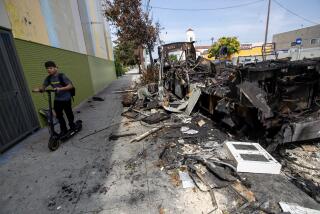SOUTH-CENTRAL : LAPD’s 77th Division Prepares for Move
- Share via
Salt air and sweat linger in the walls of the future temporary headquarters for the Police Department’s 77th Street Division.
The 37 interconnecting trailers that, come March, will take the place of the city’s most dilapidated police station used to be the living and dining quarters for hard-bitten, sore-muscled ship hands while their vessels were docked in Los Angeles Harbor for repairs.
But the unusual history of the division’s temporary home doesn’t faze Sgt. Terri Tatreau.
“We’d work out of tents if that’s what it takes (to get a new facility),” said Tatreau, who has had to contend with falling ceiling tiles, gaping holes in walls and floors, and other decrepitude during her eight years at the station.
The 70-year-old facility at 77th Street and Broadway, the department’s oldest station still in use, is scheduled to be demolished in March and replaced in two years by a $30-million, state-of-the-art successor complete with palm-lined walks and a helicopter landing pad.
In the meantime, the division’s temporary headquarters will occupy a parking lot filled with assembled wood and aluminum mobile housing units at 60th and St. Andrews streets.
The Los Angeles Harbor Department donated the prefabricated residence halls to the Police Department early last year after officers, scouting the city for a trailer suitable for a new lunchroom at 77th Street, spotted the units collecting dust at the former Todd Shipyard site in San Pedro.
The Harbor Department had acquired ownership of the units after the shipyard went bankrupt in 1990.
Once news of the trailers reached police officials, they jumped at the chance to use them to solve 77th’s larger problem of finding a temporary station.
The division’s commanding officer, Capt. Larry Goebel, asked the Harbor Department for the trailers, and port officials agreed to hand them over last February. Port officials have estimated that they saved the Police Department $400,000 by donating the units.
“We didn’t have a real need for them, and it was something that the division could use, so it was kind of a win-win (situation) for everyone,” said port spokeswoman Barbara Yamamoto.
Officers at 77th Street hope she is right: They’ve been coping with a rapidly deteriorating police station for several years.
In some of the facility’s busiest corners, duct tape keeps water-stained ceiling tiles from falling. Holding areas for prisoners appear just as dingy and neglected as the officers’ bunk room. And in the station’s interview rooms, fallen or ripped tiles form a yellowed-glue and chipped-paint patchwork across walls and ceilings.
The station is so rickety that a sign outside the front door warns that the building’s unreinforced masonry construction may crumble in a major earthquake.
Meanwhile, at the site of the temporary facility on a city-owned storage lot, workers this week busily hammered together the trailers into a cluster of long, rectangular buildings.
Construction of the facility, which will include wheelchair-accessible ramps and wooden walkways between buildings, is expected to be finished by late February, said Tom Bylard, city senior carpenter. Work at the site began in late October.
The temporary station will have 10,000 square feet more space than the current facility’s 19,000 square feet. The site will not have a jail, however. Suspects will be booked and incarcerated at either the Southeast or Southwest stations.
The cost of preparing and assembling the units is expected to run $1.2 million, all of which will be paid out of the city’s $176-million 1989 police facilities bond measure fund. Other stations slated for new facilities under the bond are the Newton and North Hollywood divisions.
Once officers abandon the temporary site for their permanent quarters, a committee of area residents will look into turning the complex of trailers into a social service or business center.
More to Read
Sign up for Essential California
The most important California stories and recommendations in your inbox every morning.
You may occasionally receive promotional content from the Los Angeles Times.










